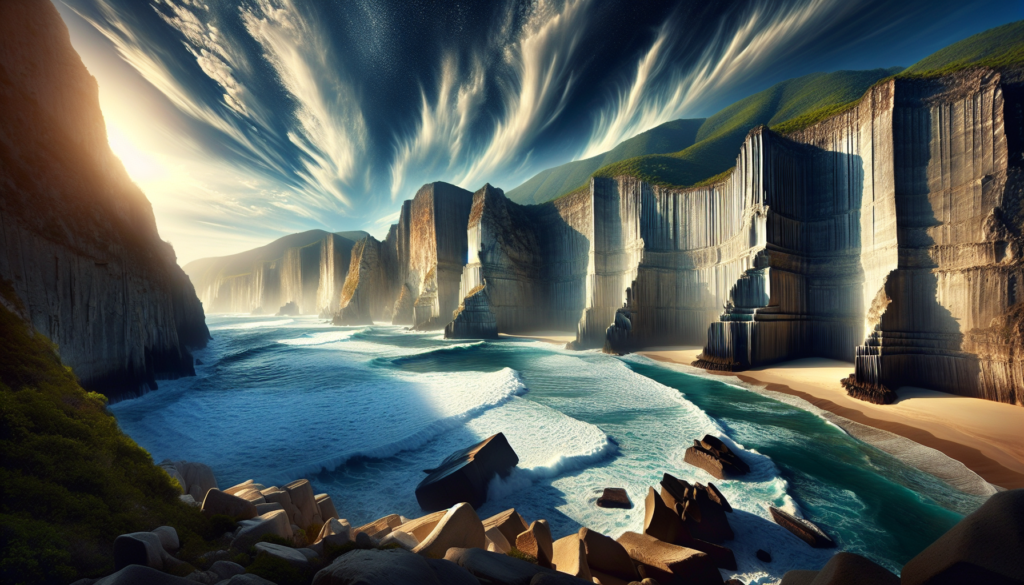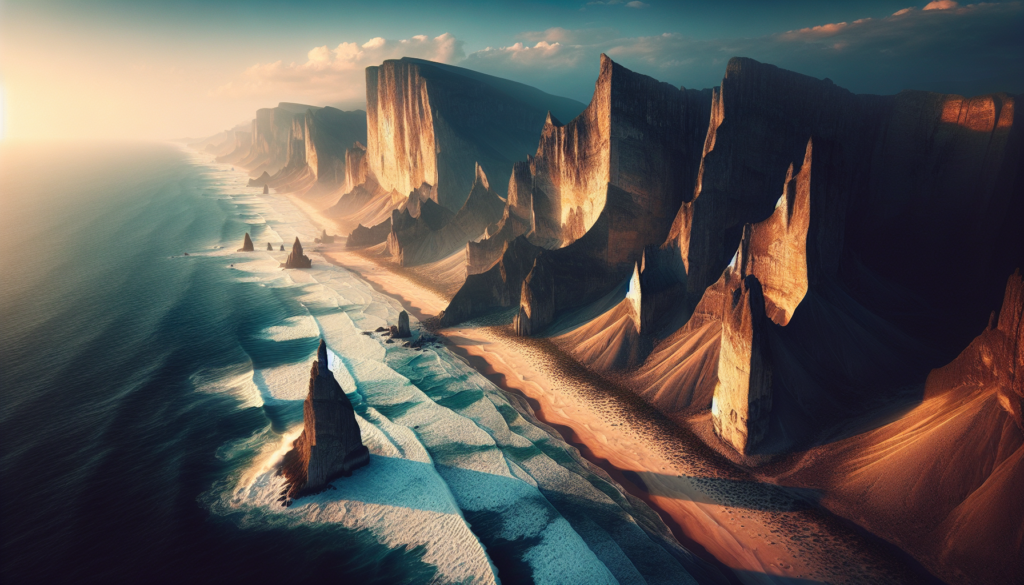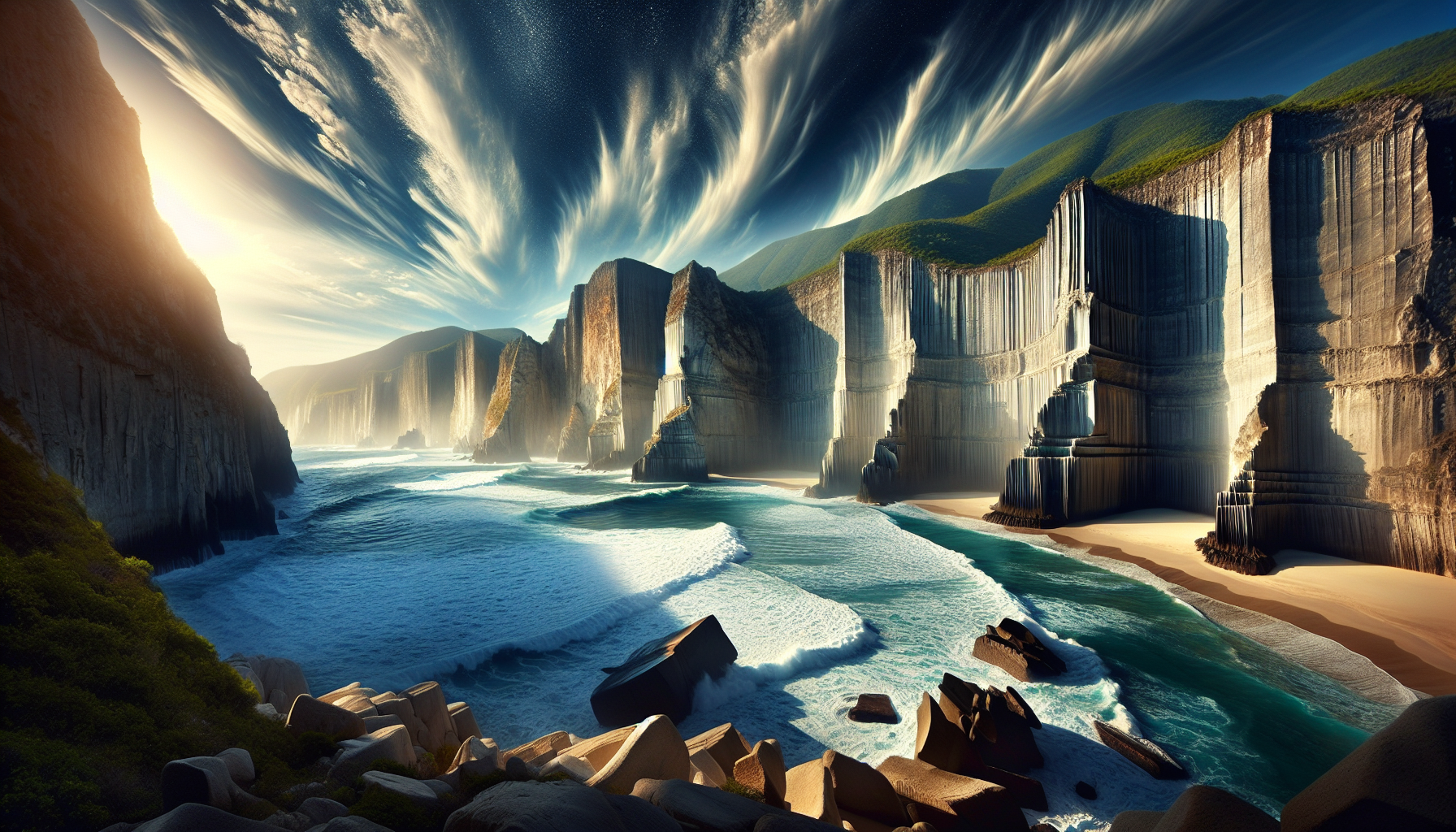Mexico’s coastal cliffs and beaches are not only breathtakingly beautiful, but they also hold fascinating geological secrets. Understanding the geology of these areas can provide invaluable insights into the formation and evolution of Mexico’s stunning coastline. From the towering cliffs of Cabo San Lucas to the pristine sandy beaches of Cancun, each coastal region has its own unique geological story to tell. In this article, we will explore the various rock formations, coastal processes, and natural wonders that shape Mexico’s coastal cliffs and beaches. Get ready to embark on a journey through time and discover the geologic wonders that make Mexico’s coastline so special.

Overview
Mexico’s coastal cliffs and beaches offer a captivating blend of geological features, showcasing the intricate processes that have shaped these stunning landscapes over millions of years. From the formation of sedimentary rocks to the influence of tectonic activity and the impact of erosion, these areas provide a fascinating glimpse into the Earth’s geological history. In this comprehensive article, we will explore the geological formation of Mexico’s coastal cliffs, the types of rock found in these areas, the unique features of its beaches, the effects of coastal erosion, the presence of fossils and their relevance to understanding geological history, noteworthy geological formations, the connection between volcanic activity and coastal geology, human interactions with these coastal environments, and future challenges and changes. Let’s dive into the captivating realm of Mexico’s coastal cliffs and beaches.
Geological Formation of Mexico’s Coastal Cliffs
General Introduction to Mexico’s Coastal Cliffs
Mexico’s coastal cliffs stretch for miles along its shores. These cliffs are a result of various geological processes that have taken place over millions of years. They provide valuable insights into the Earth’s dynamic nature and the forces that have shaped the Mexican coastline.
Formation of Sedimentary Rocks
Sedimentary rocks play a significant role in the composition of Mexico’s coastal cliffs. These rocks are formed through the accumulation and solidification of sediment, such as sand, mud, and organic matter, over time. The diverse sedimentary formations along Mexico’s coast contribute to the unique appearance of its cliffs.
Influence of Tectonic Activity on Cliff Formation
Tectonic activity, including the movement of Earth’s crustal plates, has played a crucial role in the formation of Mexico’s coastal cliffs. Subduction zones, where one tectonic plate slides beneath another, have led to the uplift of land, creating elevated coastal areas and steep cliffs.
Effect of Erosion on Cliff Features
Erosion has significantly shaped the features of Mexico’s coastal cliffs. The relentless power of waves, wind, and rain erodes the cliffs over time, resulting in distinctive formations, such as caves, arches, and sea stacks. Understanding the erosive processes is essential for comprehending the evolving nature of these cliffs.
Components of Cliff Structures
Mexico’s coastal cliffs exhibit unique geological structures. These structures are composed of various layers of sedimentary rocks, faults, fractures, and joint systems. The combination of these components contributes to the overall stability and appearance of the cliffs.
Specific Examples of Coastal Cliffs in Mexico
Mexico is blessed with numerous breathtaking coastal cliffs. From the impressive cliffs of Acapulco to the picturesque formations of Cabo San Lucas, each region showcases distinctive geological characteristics. Exploring these specific examples allows for a deeper understanding of the geological diversity found along Mexico’s coastline.
Comparisons to Cliffs in Other Regions
While Mexico’s coastal cliffs are unique, it is helpful to compare them to cliffs found in other parts of the world. By examining similarities and differences, we can gain insights into the broader geological processes that shape coastal regions worldwide.
Types of Rock Found in Mexico’s Coastal Cliffs
Introduction to Rock Types
Mexico’s coastal cliffs are composed of a wide range of rock types. Understanding these rock formations is crucial for unraveling the geological history and processes that have shaped the cliffs over time.
Igneous Rocks on Mexico’s Coastline
Igneous rocks, formed through the crystallization of molten magma, are found along Mexico’s coastline. These rocks provide evidence of past volcanic activity and contribute to the geological diversity of the cliffs and beaches.
Sedimentary Rocks and their Characteristics
Sedimentary rocks dominate Mexico’s coastal cliffs, with their various layers telling a story of ancient oceans, rivers, and depositional environments. Each sedimentary rock type carries distinct features that help us comprehend the geological processes that have shaped these cliffs.
Metamorphic Rocks Found in Coastal Areas
Metamorphic rocks, formed through the transformation of pre-existing rocks under intense heat and pressure, are also present in certain coastal areas of Mexico. These rocks provide invaluable clues about the intense geological forces that have shaped the landscape.
Examples of Different Rock Types in Mexico’s Cliffs
Mexico’s coastal cliffs exhibit a remarkable variety of rock types. From the basalt columns of Los Arcos in Puerto Vallarta to the limestone cliffs of Tulum, each region showcases distinct rock formations that contribute to the visual splendor and geological significance of Mexico’s coastal cliffs.
Geological Features of Mexico’s Beaches
Formation of Sandy Beaches
Mexico’s beaches are renowned for their pristine sandy shores. These sandy beaches are formed through a complex interplay of factors, including the erosion of coastal cliffs, the transportation of sediment, and the action of waves and currents.
Coastal Dunes and their Formation
Coastal dunes are another fascinating geological feature found in Mexico’s coastal areas. These dunes are created by wind-driven processes, as sand particles are deposited and shaped by prevailing winds, leading to the formation of vast mounds of sand.
Influence of Wave Action on Beach Formation
Waves play a crucial role in shaping Mexico’s beaches. The relentless action of waves affects the size and composition of sediment, creates distinctive beach profiles, and influences the formation of coastal features such as spits and barrier islands.
Variations in Beach Profiles
Mexico’s coastal beaches display a diverse range of profiles, from gently sloping to steep and cliff-backed shorelines. Understanding the variations in beach profiles helps us appreciate the unique characteristics and geological processes at work in each region.
Features Specific to Mexico’s Beaches
Mexico’s beaches exhibit certain features that set them apart from other beach destinations. From the vibrant colors of the Caribbean Sea to the magnificent hidden cenotes of the Yucatan Peninsula, these unique attributes add to the geological allure of Mexico’s coastal areas.
Importance of Beach Ecosystems
Beaches are not just geological formations; they are also vibrant ecosystems teeming with life. Mexico’s coastal beaches are home to a wide array of plant and animal species, including nesting sea turtles, mangroves, and coastal dune vegetation. Understanding the importance of these ecosystems is essential for their preservation and conservation.

Coastal Erosion and its Impacts
Introduction to Coastal Erosion
Coastal erosion is an ongoing natural process that poses significant challenges to Mexico’s coastal cliffs and beaches. Understanding this process helps us grasp the changes in landforms and the impact on coastal communities and ecosystems.
Factors Affecting Erosion Rates
Various factors contribute to the rate of coastal erosion. These include wave energy, the type of sediment, sea level rise, tides, and human activities. Understanding these factors provides insights into the vulnerability of coastal areas to erosion.
Impacts of Erosion on Cliffs and Beaches
Coastal erosion has significant effects on Mexico’s coastal cliffs and beaches. Eroding cliffs result in instability, potential landslides, and the loss of valuable habitats. Eroded beaches pose threats to infrastructure, tourism, and coastal ecosystems. Assessing these impacts is crucial for the sustainable management of these valuable coastal resources.
Mitigation Measures to Protect Coastal Environments
To combat the destructive forces of coastal erosion, various mitigation measures have been employed in Mexico. These include the construction of sea walls, beach nourishment projects, dune restoration, and the implementation of zoning regulations. Examining these measures highlights the importance of balancing human needs with the preservation of the natural environment.
Examples of Erosion Management in Mexico
Mexico has implemented numerous erosion management initiatives along its coastal areas. From the innovative techniques used in Cancun to protect its famous beaches to the restoration projects in Puerto Escondido, these examples showcase Mexico’s commitment to safeguarding its coastal resources.
Fossils and Geological History
Significance of Fossils in Geology
Fossils are invaluable tools for understanding the geological history of Mexico’s coastal cliffs and beaches. These preserved remnants of ancient life provide clues about past environments, climate, and the evolution of species. Studying fossils helps piece together the puzzle of Mexico’s geological past.
Common Fossils Found in Mexico’s Coastal Cliffs and Beaches
Mexico’s coastal cliffs and beaches are fossil-rich environments, offering a treasure trove of ancient life forms. From the abundant marine fossils of the Cretaceous Period to the intriguing remains of prehistoric land animals, each fossil discovery adds to our knowledge of the region’s geological history.
Interpreting Fossils to Understand Geological History
Fossils are not just artifacts of the past; they provide valuable insights into the geological processes that have shaped Mexico’s coastal cliffs and beaches. By studying fossil assemblages, researchers can reconstruct ancient environments, decipher past ecological interactions, and develop a detailed understanding of geological history.
Major Geological Events in Mexico’s Coastal Areas
Mexico’s coastal areas have been shaped by significant geological events throughout history. These events include volcanic eruptions, the formation of ancient seas, and the interaction of tectonic plates. Understanding these events is crucial for unraveling the complex geological tapestry of Mexico’s coastal regions.
Geological Time Scale and its Relevance
The geological time scale provides a framework for understanding the immense spans of time over which geological processes have occurred. It enables scientists to correlate fossil assemblages, sedimentary layers, and rock formations, contributing to a comprehensive understanding of Mexico’s coastal cliffs and beaches.
Unique Geological Formations in Mexico’s Coastal Areas
Caves and Cenotes along Mexico’s Coastline
Mexico’s coastal areas are famed for their captivating caves and cenotes. These geological wonders are a result of the dissolution of soluble rocks, such as limestone, creating underground caverns and sinkholes. Exploring these subterranean worlds sheds light on the intricate geological processes shaping Mexico’s coasts.
Formation of Sea Stacks and Natural Arches
Sea stacks and natural arches are spectacular geological formations found along Mexico’s coastal cliffs. These formations are a testament to the relentless power of wave erosion, which has sculpted the cliffs into these magnificent structures. Examining the processes behind their formation enhances our appreciation of the ever-changing coastal landscapes.
Presence of Sinkholes in Coastal Regions
Sinkholes, or dolines, are common features in Mexico’s coastal regions. Formed through the collapse of underground caves and caverns, sinkholes leave behind intriguing features that reveal the complex nature of the subterranean world and its connection to the coastal environment.
Underwater Caves and Geological Exploration
Mexico’s coastal areas are known for their extensive networks of underwater caves, known as cenotes. These caves offer exciting opportunities for geological exploration, with their pristine waters and hidden geological formations providing insights into Mexico’s coastal geology not accessible through other means.
Examples of Noteworthy Geological Formations
Mexico’s coastal areas boast several noteworthy geological formations that capture the imagination. From the stunning El Arco rock formation in Cabo San Lucas to the eerie beauty of the Cenote Angelita in Tulum, each formation contributes to the unique geological heritage of Mexico’s coastal areas.
Volcanic Activity and Coastal Geology
Influence of Volcanoes on Coastal Landforms
Volcanic activity has had a significant impact on the formation of coastal landforms in Mexico. Volcanic eruptions have deposited layers of volcanic ash, leading to the formation of unique cliffs and beaches. Understanding the interplay between volcanic activity and coastal geology provides insights into Mexico’s diverse coastal landscape.
Volcanic Islands in Mexico’s Coastal Waters
Mexico is home to several volcanic islands located off its coastline. These islands, such as Isla Socorro and Isla de Guadalupe, serve as reminders of past volcanic activity and offer unique geological and ecological environments for study and exploration.
Volcanic Eruptions and their Impact on Coastal Geology
Volcanic eruptions have left a profound imprint on Mexico’s coastal geology. Ash deposits from eruptions can be found in the cliffs and beaches, providing evidence of past volcanic events and their lasting influence on the landscape. Examining these deposits helps unravel Mexico’s volcanic history.
Volcanic Ash Deposits on Cliffs and Beaches
The presence of volcanic ash in Mexico’s coastal cliffs and beaches is a testament to the explosive nature of volcanic eruptions. These ash deposits contain valuable information about volcanic processes, past eruptions, and the environmental conditions prevailing at the time of deposition.
Volcanism and Beach Sand Composition
Volcanic activity significantly influences the composition of beach sand found along Mexico’s coast. Volcanic rocks are weathered and eroded, releasing fine particles that contribute to the composition of beach sediments. Understanding the relationship between volcanism and beach sand composition adds another layer to the story of Mexico’s coastal geology.
Human Interactions with Mexico’s Coastal Cliffs and Beaches
Coastal Development and Its Effects on Cliff Stability
Coastal development, including the construction of infrastructure and resorts, has had profound effects on Mexico’s coastal cliffs. The alteration of natural coastal processes and the removal of stabilizing vegetation can lead to increased erosion rates and instability in these areas. Examining the impact of coastal development helps identify ways to mitigate the consequences.
Beach Tourism and its Impact on Coastal Environments
Mexico’s coastal cliffs and beaches attract millions of visitors each year, drawn to their beauty and recreational opportunities. However, uncontrolled tourism can place undue stress on fragile coastal ecosystems, leading to habitat destruction, pollution, and increased erosion. Exploring sustainable tourism practices is crucial for balancing economic growth with environmental preservation.
Conservation Efforts to Preserve Geologically Unique Areas
Recognizing the importance of preserving geologically unique areas, Mexico has implemented various conservation efforts. The creation of protected areas, such as national parks and reserves, helps safeguard the geological heritage of Mexico’s coastal cliffs and beaches, ensuring their long-term viability.
Coastal Mining and its Environmental Consequences
Coastal areas in Mexico are sometimes exploited for mineral resources, such as sand and gravel. Coastal mining can have severe environmental consequences, including habitat destruction, erosion, and water pollution. Examining the impacts of coastal mining raises awareness of the need for sustainable resource extraction practices.
Coastal Cliffs and Beaches in Cultural Context
Mexico’s coastal cliffs and beaches hold cultural significance for communities living near these areas. They are intertwined with folklore, indigenous traditions, and historical narratives. Understanding the cultural context helps foster a holistic approach to the conservation and appreciation of Mexico’s coastal geology.
Future Changes and Challenges
Climate Change and its Impact on Coastal Geology
Climate change poses significant challenges to Mexico’s coastal cliffs and beaches. Rising temperatures, sea level rise, and intensified storms can accelerate erosion rates and alter coastal processes. Examining the impact of climate change helps identify strategies to mitigate its effects and protect these fragile environments.
Rising Sea Levels and Coastal Erosion
One of the most pressing challenges facing Mexico’s coastal cliffs and beaches is rising sea levels. As sea levels continue to rise, coastal erosion rates are expected to increase, posing significant risks to infrastructure, ecosystems, and human settlements. Developing adaptation strategies is crucial for ensuring the resilience of these coastal areas.
Adaptation Strategies for Coastal Areas
Adapting to the challenges posed by climate change and rising sea levels requires the implementation of robust strategies. Examples of adaptation measures include beach nourishment, the construction of artificial reefs, the restoration of dune systems, and nature-based solutions. These strategies aim to reduce vulnerability and enhance the resilience of Mexico’s coastal cliffs and beaches.
Predictions for the Future of Mexico’s Coastal Cliffs and Beaches
Predicting the future of Mexico’s coastal cliffs and beaches is a challenging task. However, based on current trends and scientific projections, it is possible to anticipate potential changes, such as increased erosion rates, altered beach profiles, and the shifting of coastal ecosystems. Considering these predictions helps inform management decisions and conservation efforts.
Research and Monitoring in Coastal Environments
Ongoing research and monitoring efforts are crucial for understanding the evolving dynamics of Mexico’s coastal cliffs and beaches. By collecting data on erosion rates, sediment transport, and ecological changes, scientists can improve our understanding of these complex environments and inform management strategies. Investing in research and monitoring is vital for the sustainable future of Mexico’s coastal geology.
In conclusion, the geology of Mexico’s coastal cliffs and beaches is a captivating subject that encompasses a wide range of fascinating topics. From the geological formation of cliffs to the types of rocks found, the unique features of beaches, the impact of coastal erosion, the presence of fossils, and the influence of volcanic activity, Mexico’s coastal areas offer a wealth of geological wonders waiting to be explored. Understanding these geological processes and their interplay with human interactions and future challenges is essential for the preservation and appreciation of Mexico’s coastal geology. So grab your virtual geological pickaxe and join us as we delve into the mesmerizing realm of Mexico’s coastal cliffs and beaches.
